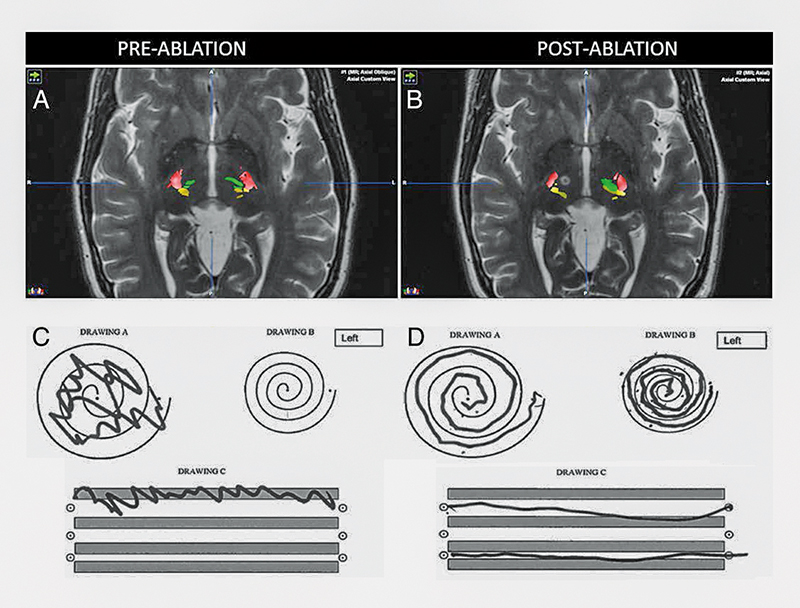
Current treatments include drug therapies, surgery and deep brain stimulation. There are over one million people with essential tremor in Britain and around 250,000 people with the syndrome are severely disabled by their tremor. There are many causes of severe tremor – it is a syndrome rather than a specific condition. MRgFUS for essential tremorĮssential tremor is a shake of a part of the body that cannot be controlled. The technology is currently used to treat conditions such as uterine fibroids and at the Trust, we are currently trialling its use in the treatment of low grade prostate cancer.

MRgFUS allows clinicians to target a very specific focal point – with very little heating produced in front of and behind that point, so only the targeted tissue is affected. That heat can “cook” tissue and destroy it. At that point, molecules are vibrated extremely quickly, which creates intense local heat. Magnetic resonance-guided focused ultrasound (MRgFUS) technology uses MRI imaging to guide high powered, focused ultrasound to a very small point.

#Focused ultrasound for essential tremor trial#
However, currently we have good information on patients up to 3 years after MR-guided Focused Ultrasound showing that the tremor remains well suppressed in the treated arm in most but not all patients.Thanks to a grant from Imperial College Healthcare Charity, the Trust was able to acquire specialist equipment to trial magnetic resonance-guided focused ultrasound to treat essential tremor. The answers to these questions are not known as it is a relatively new procedure. Will the tremor return afterwards and how long will the beneficial effects of MR-guided focused ultrasound last? Although, these symptoms, should they occur, usually resolve within a few months there is the possibility that one or more of these adverse effects might remain permanently. The main adverse effects of MRgFUS are caused by cerebral oedema (temporary swelling around the target site in the brain), which may lead to worsening of speech and walking and also numbness, involuntary movements or weakness on the treated side of the body (including face, arm and leg). As it is done in an MRI scanner whilst the patient is awake it may not be possible in patients with claustrophobia (fear of enclosed spaces). The frame is required to prevent the head from moving during the procedure. There can be some intrusive pain and discomfort from the pins that hold the frame to the patients head. The MR-guided Focused Ultrasound procedure is performed with the patient awake and can be somewhat of an ordeal patients often reporting a feeling of dizziness or pressure around the head which may occur several times during ‘sonications’ and lasts for 10-15 seconds on each occasion. In addition if the patient has other serious medical conditions it may be unwise to undergo MR-guided Focused Ultrasound. Generally patients with significant speech impairments, unsteadiness of gait, moderate cognitive impairments or dementia should not be treated with MR-guided Focused Ultrasound, as these could deteriorate after the procedure.

Mary's Hospital, Imperial College NHS trust describes MRgFUS, how it works, who it is for, the key benefits and the considerations of treatment Professor Wladyslaw Gedroyc, consultant Radiologist at St. Since April this year (2021) MRgFUS is available on the NHS in England for the treatment of people with essential tremor, having received a positive guidance from NICE in June 2018.Īn animated video explaining how MRgFUS works featuring Ian Sharp, who is among the first people in Scotland to be treated with MRgFUS at Ninewells Hospital from the University of Dundee. The treatment takes approximately 4 hours and many patients can experience an immediate reduction in their tremor, however, their ability to regain skills such as writing, picking up a cup, using cutlery, doing up buttons and zips, using a phone or computer may take longer to recover. High intensity focused ultrasound is used to destroy one or two small areas of tissue in the brain which are responsible for the tremor. The treatment combines two technologies – high intensity focused ultrasound (FUS), that is guided by Magnetic Resonance (MR) Imaging. MRgFUS, or Magnetic Resonance-guided Focused UltraSound, is a safe, cost effective and incisionless procedure for the treatment of essential tremor. Trials have been shown to deliver similar patient outcomes to Deep Brain Stimulation (DBS), often in an outpatient setting, and NHS England has now determined that this should also be available as an NHS service. MRgFUS, or Magnetic Resonance-guided Focused UltraSound, is an incisionless procedure for the treatment of Essential Tremor


 0 kommentar(er)
0 kommentar(er)
